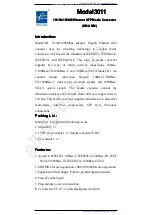
Page 36 H0 Sound Decoder MX640
CV
Designation
Value
range
De-
fault
Description
#341
Switch input 1
Playback time
0 - 255
=
0 - 255 sec
0
The sound sample allocated to switch input 1 is played back
for the duration defined with this CV.
= 0: Play sample back once (as recorded)
# 342
Switch input 2
Playback time
0 - 255
=
0 - 255 sec
0
The sound sample allocated to switch input 2 is played back
for the duration defined with this CV.
= 0: Play sample back once (as recorded)
# 342
Switch input 3
(if not used for the cam
sensor)
Playback time
0 - 255
=
0 - 255 sec
0
The sound sample allocated to switch input 3 is played back
for the duration defined with this CV.
= 0: Play sample back once (as recorded)
Installing new sound samples in ZIMO sound decoders:
WILL BE ADDED LATER or check
New sound samples can be installed with the software “ZST” (ZIMO Service Tool), the
MXDECUP
(decoder update module)
or the
MX31ZL
directly on the track without opening the locomotive.
Projects for future SW versions of the MX640 sound decoder:
The ZIMO sound decoder MX640 implemented as described on the previous pages corresponds to
the software version 4. The following extensions and improvements are planned for future SW up-
dates. Also included, as far as possible, will be suggestions made by users.
The project
“CV sets”,
which has already been implemented to some extend in connection with
other features, will gain new significance for sound decoders: Many adjustments in the area of
sound selection, sound allocation and CV’s are actually not just dependent on the engine type but
on the operating situation as well (i.e. load dependency, brake squeal but also non-sound functions
such as lighting). For this reason it is planned to offer a way of easily switching between several
stored parameters (CV sets).
7. Bidirectional communication = “RailCom”
The future oriented technology for which all ZIMO decoders have been prepared since 2004 (hardware), has also
been installed in the MX640 decoders and is functional from the beginning (basic functions).
“Bidirectional” means that the information transfer within the DCC protocol is not only flowing towards the decoder
but also in the opposite direction; that is not just driving, function and switch commands are being sent to decoders
but also messages such as acknowledgements and status information are being transmitted by the decoders.
The definitions for RailCom are determined by the “RailCom working group” (Lenz, Kühn, Tams and ZIMO),
before that by the NMRA RP’s 9.3.1 and 9.3.2 for bidirectional communication; with the goal of a uniform
platform for “RailCom” applications.
The functionality is based on short cut-outs (max. 500 micro seconds) introduced to the otherwise continuously
sent DCC signal by the command station. These cut-outs provide the opportunity and enough time for the decod-
ers to send a few bytes of data to locally mounted detectors.
With the help of
= bidirectional communication, it will
be possible that the decoder can acknowledge received commands, -
- this increases operational reliability and the bandwidth of the DCC system because already ac-
knowledged commands don’t need to be sent repeatedly;
send current data from decoders to the command station -
- e.g. “real” train speed, motor load, routing and position codes, “fuel reserves”, current CV values on
demand from decoders to the command station or more precisely, to a “
global detector”
in the
command station;
decoder addresses are recognized by “local” detectors -
- the actual loco positions are determined by local detectors connected to individual track sections (inte-
grated in future MX9 track section modules). This however has been possible with ZIMO’s own loco num-
ber recognition for over a decade without bidirectional communication, but only with ZIMO components.
Starting in 2007, RailCom will be further developed over the coming years and will bring new applications,
which of course require new software updates in decoders and other equipment. In the first phase - 2008,
SW version 18 – ZIMO large-scale decoders will be able to send their own loco address from an isolated
section of track (with a so called broadcast method, very fast, although only for one loco inside that section)
with some decoder data such as actual speed, load and decoder temperature.
On the system side, a third party product is available from the beginning – the address display LRC120,
which is a “local” RailCom detector displaying the loco address of one track section. In the course of 2007,
the MX31ZL will become available with an integrated “global” RailCom detector and finally “global” RailCom
detectors for the installation into ZIMO command stations MX1EC, MX1, MX1HS as well as MX31 cabs.
The RailCom function is activated with CV #29, Bit 3 and is also the default setting (see chapter 3 and CV
list)
"RailCom" is a trademark of Lenz Elektronik GmbH.










































